Hapi: Early Egyptian God Of The Nile And Bringer Of Fertility, Abundance And Life
A. Sutherland - AncientPages.com - Hapi (also spelled Hep, Hapy, or Hepy) was the early Egyptian god of the Nile River.
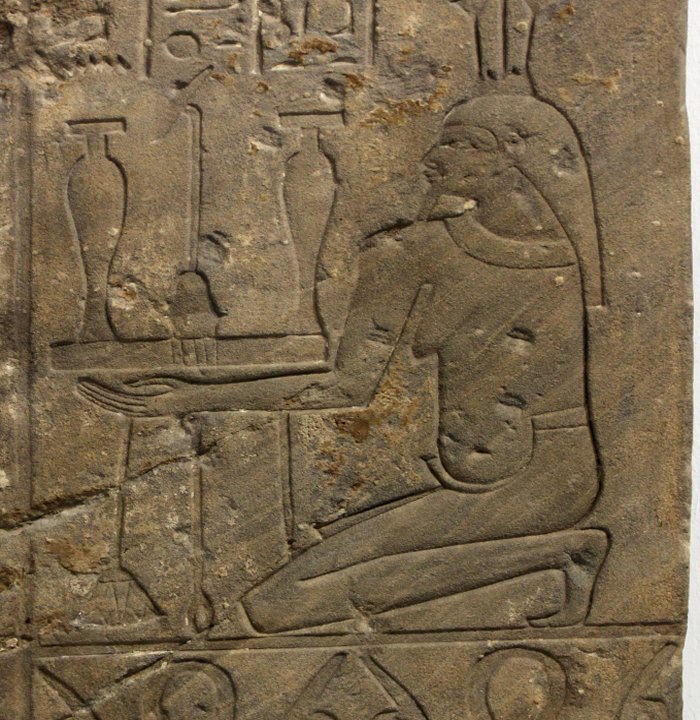 Fragment of a temple relief with Nile god Hapi. The inscription on the fieze reads "all luck, all life" which is what was hoped for; Medinet (Egypt); 746-655 BC. Image credit: Anagoria - source
Fragment of a temple relief with Nile god Hapi. The inscription on the fieze reads "all luck, all life" which is what was hoped for; Medinet (Egypt); 746-655 BC. Image credit: Anagoria - source
He was a very ancient deity, even for Egyptians of old times. Hapi was depicted as a fat man with a ceremonial false beard, an enlarged belly, and pendulous breasts.
His skin was green or blue. The deity was often depicted with a clump of papyrus on his head and lotus stalks and keeping a tray laden with offerings.
His appearance symbolized his ability to feed the land using the Nile's annual floods and bring fertility to the country.
The god's body was believed to bring abundance and fertility to the people.
The ancient Egyptians lived in pre-scientific times and had no knowledge about seasonal rains that caused the Nile waters to rise yearly.
They thought the Nile flooded on orders from the gods. If the gods were angry, they could punish people with a drought, and their crops would die, but too much flooding was dangerous and devastating for agriculture. The gods' representative on earth was a king, so he could help to secure the living in the Nile Valley.
"A king who was a god could intercede with his brother god Hapi to ensure the valley received a good flood each year. And this became one of Pharaoh's most important duties. Every June, when the flood was due, he voyaged to Egypt's upper borders, where the waters began to rise. In a solemn ceremony, Pharaoh "spoke" to his brother Hapi and exacted his promise to send the kemi-laden waters down into the valley once again." 1
The upper part of a statue of the Nile God Hapi. Granite. From Faiyum, Egypt, 12th Dynasty, c. 1800 BCE. Neues Museum, Berlin, Germany. Image credit: Osama Shukir Muhammed Amin - CC BY-SA 4.0
He provided water, food, and the annual flooding of the Nile River. Interestingly, though Egypt depended on these floodings, Hapi was not a high-ranking divinity in ancient Egyptian beliefs.
Hapi's domain was the Nile, the great river divided into two parts.
As a god of the northern Nile, Hapi (called "Hap-Meht") was portrayed wearing papyrus plants, a symbol of Lower Egypt, on his head. As the Nile god of Upper Egypt, he was known as "Hap-Reset" and wore lotus plants (a symbol of the south) on his head.
Sometimes, both papyrus and lotus were combined in a single figure, and the god was shown holding both plants in his hands.
Hapi's female counterparts and wives were, respectively, Nekhebet, goddess of the south, shown as a vulture, and Buto, his goddess of the north, portrayed as a cobra. Hapi also had other divine associations with gods who had created the world and everything within the universe. We find him credited with the attributes of Nu, the oldest of the ancient Egyptian gods and father of Ra, the sun god.
Limestone slab showing the Nile flood god Hapi. 12th Dynasty. From the foundations of the temple of Thutmose III, Koptos, Egypt. Petrie Museum of Egyptian Archaeology, London. Image credit: Osama Shukir Muhammed Amin - CC BY-SA 4.0
The ancient Egyptians had an enormous pantheon of gods and goddesses, but who was vital for them and their daily lives? Certainly, Ra was significant; he represented the Sun, and without it, Egypt would have been thrown into darkness. Hapi was highly important, too. Without the Nile, every living creature would undoubtedly have perished.
During the annual flooding (known as the 'arrival of Hapi'), the Egyptians used to bring amulets and offerings and make other sacrifices at certain - sacred to Hapi - places, along with the Nile. A great, mighty flood was called a 'large Hapi,' while a low flood was a 'small Hapi.'
Hapi arrived with water, and the people and animals were happy. He was called the one "who greens the Two Banks" and was also recognized as the maker of barley and wheat.
Eventually, Hapi was identified with Osiris, a river or water god. The Egyptians gave him a role in reviving the murdered Osiris, who returned each year with the barley.
The flood was widely known as the "arrival of Hapi." The Egyptians made sacrifices to the Nile to satisfy Hapi. They prayed and honored him by walking through villages and cities, carrying his small statues and amulets. Hymns to Hapi were very popular and expressed the people's gratitude for his generosity in bringing floods that nourished the country's soil and gave them food each year.
The floods, though very powerful sometimes, were considered necessary as they irrigated and fertilized the Nile valley each year. Hapi was responsible for these powers; the ancient Egyptians needed them for his soil and animals. In symbolic meaning, the yearly flooding of the Nile was a defense against the hostile desert that threatened all life in the region.
His other titles were the 'Lord of Fishes and Birds of the Marshes' because he brought them along with the Nile to the Egyptians.
The deity, portrayed on the walls of many Egyptian temples, was rarely depicted as a single god but was usually seen in pairs or groups of fertility deities carrying the food of Lower and Upper Egypt.
In the Predynastic Period (before 3100 BC), the name Hapi referred to both the river and the god, but later, the god was called Hapi, and the river became iterw, meaning "the running one" or "the river."
Written by – A. Sutherland - AncientPages.com Senior Staff Writer
Updated on January 23, 2024
Copyright © AncientPages.com All rights reserved. This material may not be published, broadcast, rewritten or redistributed in whole or part without the express written permission of AncientPages.com
Expand for references1. Payne, E. The Pharaohs of Ancient Egypt
Wilkinson, R. H. The Complete Gods and Goddesses of Ancient Egypt
More From Ancient Pages
-
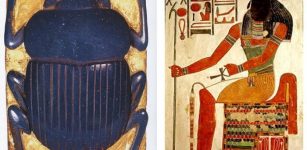 Khepri – Egyptian Progenitor God, Spirit Of Life, Resurrection And The Rising Sun
Egyptian Mythology | May 14, 2020
Khepri – Egyptian Progenitor God, Spirit Of Life, Resurrection And The Rising Sun
Egyptian Mythology | May 14, 2020 -
 Controversial Unexplained Ancient Mystery In Mongolia – Horrifying Sight – Part 2
Ancient Mysteries | May 2, 2018
Controversial Unexplained Ancient Mystery In Mongolia – Horrifying Sight – Part 2
Ancient Mysteries | May 2, 2018 -
 Cave Art In ‘Painting Room’ – At Ojo Guareña (Burgos) Is Over 12,000 Years Old
News | Oct 2, 2020
Cave Art In ‘Painting Room’ – At Ojo Guareña (Burgos) Is Over 12,000 Years Old
News | Oct 2, 2020 -
 Jiroft’s Konar Sandal – Home To A Huge Ziggurat And Many Ancient Treasures
Featured Stories | Jun 8, 2021
Jiroft’s Konar Sandal – Home To A Huge Ziggurat And Many Ancient Treasures
Featured Stories | Jun 8, 2021 -
 Mystery Of Pre-Adamic Didanum Race: Giants Who Were Ancestors Of The Nephilim and Rephaim
Biblical Mysteries | Oct 2, 2014
Mystery Of Pre-Adamic Didanum Race: Giants Who Were Ancestors Of The Nephilim and Rephaim
Biblical Mysteries | Oct 2, 2014 -
 10 Types Of Ancient Crosses In Different Cultures Explained
Featured Stories | May 23, 2017
10 Types Of Ancient Crosses In Different Cultures Explained
Featured Stories | May 23, 2017 -
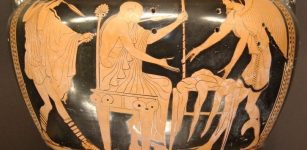 Prophet King Phineus Revealed The Future To Humans And Unleashed God Zeus’ Fury
Featured Stories | Nov 20, 2019
Prophet King Phineus Revealed The Future To Humans And Unleashed God Zeus’ Fury
Featured Stories | Nov 20, 2019 -
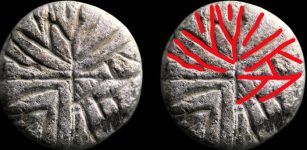 Playing Piece With Runic Inscription Found In Trondheim
Archaeology | Jun 20, 2023
Playing Piece With Runic Inscription Found In Trondheim
Archaeology | Jun 20, 2023 -
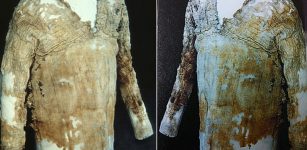 Tarkhan Dress – The World’s Oldest Woven Garment
Archaeology | Feb 24, 2016
Tarkhan Dress – The World’s Oldest Woven Garment
Archaeology | Feb 24, 2016 -
 DNA Reveals Neanderthals’ Own Blood May Have Led to Their Demise, Scientists Say
Evolution | Jan 27, 2025
DNA Reveals Neanderthals’ Own Blood May Have Led to Their Demise, Scientists Say
Evolution | Jan 27, 2025 -
 Revealing 1,200 Years Of Arctic Canadian Cultures And Settlements In Canada
Archaeology | Jul 11, 2024
Revealing 1,200 Years Of Arctic Canadian Cultures And Settlements In Canada
Archaeology | Jul 11, 2024 -
 Discovery In Alabama Reveals Evidence Of Skull Surgery In North America Thousands Of Years Earlier Than Previously Thought
Archaeology | Apr 2, 2022
Discovery In Alabama Reveals Evidence Of Skull Surgery In North America Thousands Of Years Earlier Than Previously Thought
Archaeology | Apr 2, 2022 -
 Largest Ancient Gold Treasure Of Its Kind Discovered In Stavanger, Norway
Archaeology | Sep 7, 2023
Largest Ancient Gold Treasure Of Its Kind Discovered In Stavanger, Norway
Archaeology | Sep 7, 2023 -
 10 Great Ancient Mysteries Of Peru
Featured Stories | May 17, 2016
10 Great Ancient Mysteries Of Peru
Featured Stories | May 17, 2016 -
 Crannogs – Artificial Islands In Scotland Are Older Than Stonehenge
Archaeology | Jun 17, 2019
Crannogs – Artificial Islands In Scotland Are Older Than Stonehenge
Archaeology | Jun 17, 2019 -
 The Green Knight – New Movie Based On Arthurian Legend
Myths & Legends | Aug 7, 2021
The Green Knight – New Movie Based On Arthurian Legend
Myths & Legends | Aug 7, 2021 -
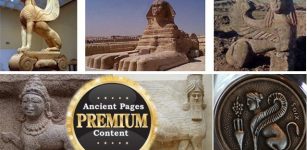 Mystery Of The Sphinx – A Guardian Of Knowledge And Symbol Of Riddles And Intrigue
Ancient Mysteries | Oct 13, 2015
Mystery Of The Sphinx – A Guardian Of Knowledge And Symbol Of Riddles And Intrigue
Ancient Mysteries | Oct 13, 2015 -
 Was Ancient Egyptian Science Inherited From A Lost Atlantean Civilization?
Ancient Mysteries | Sep 4, 2017
Was Ancient Egyptian Science Inherited From A Lost Atlantean Civilization?
Ancient Mysteries | Sep 4, 2017 -
 A Bronze Age Food Vessel Unearthed During A High Street Demolition 42 Years Ago Has Gone On Display At A Nearby Museum
Archaeology | Sep 13, 2022
A Bronze Age Food Vessel Unearthed During A High Street Demolition 42 Years Ago Has Gone On Display At A Nearby Museum
Archaeology | Sep 13, 2022 -
 Mythical Shield-Maidens Did Exist – Evidence Of Female Viking Warriors Discovered
Archaeology | Sep 9, 2017
Mythical Shield-Maidens Did Exist – Evidence Of Female Viking Warriors Discovered
Archaeology | Sep 9, 2017


